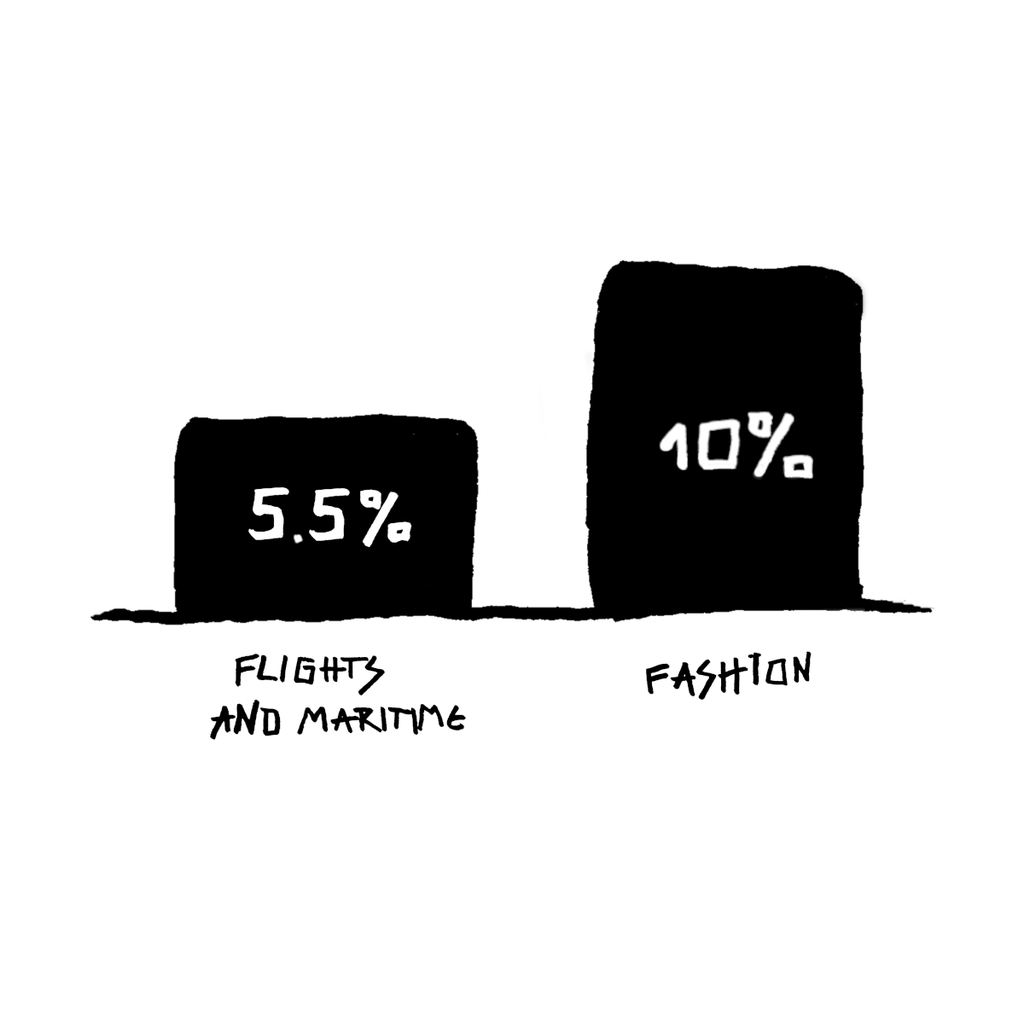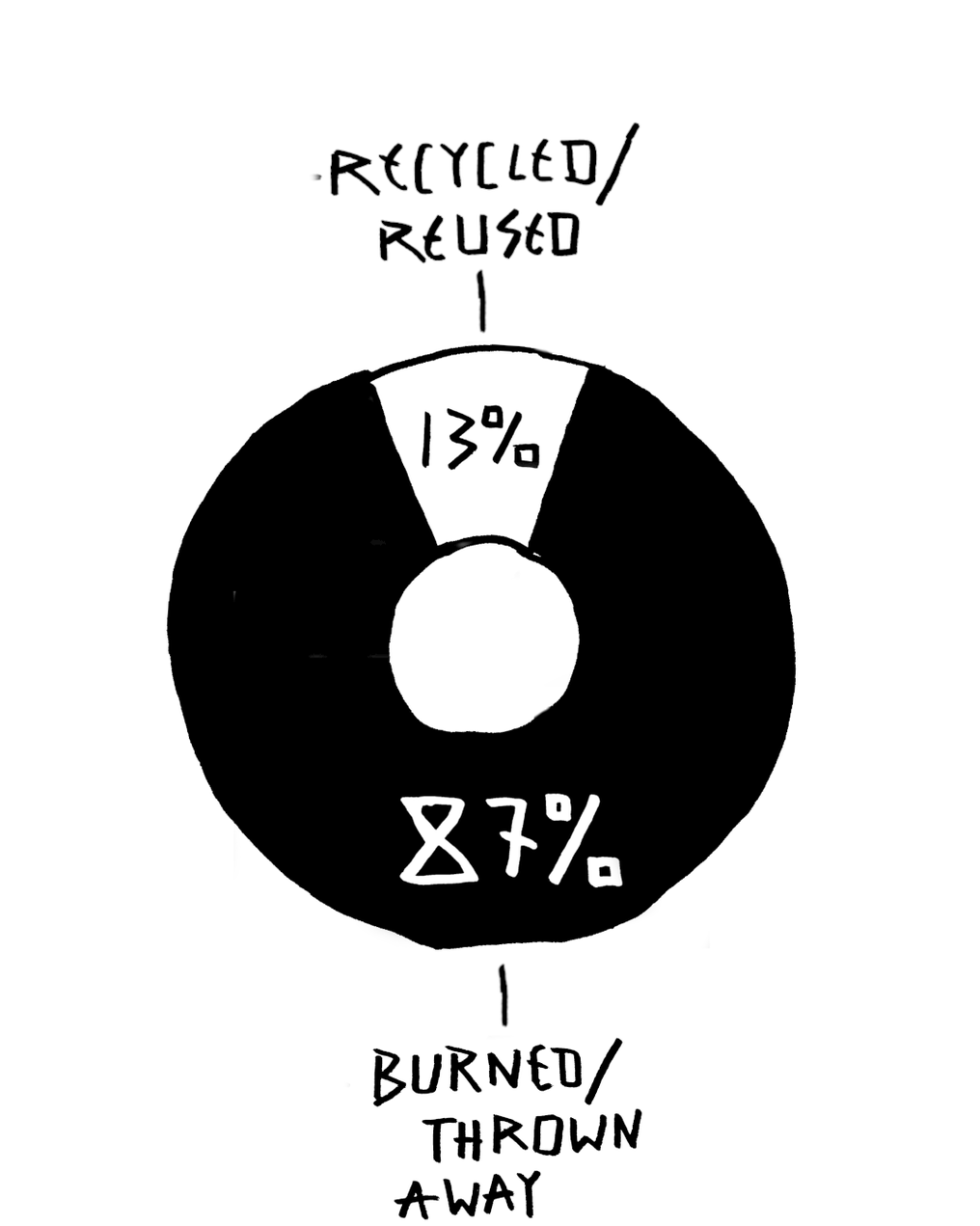
The downside of the €10 camo print boyfriend jeans
Large fashion brands want you to buy as many clothes as fast and often as possible. Every few weeks, new collections hit the runways, or nowadays mostly social media and online shops. With the help of influencers, fashion brands captivate consumers' attention and lure them into following the newest trends, ‘reinventing’ themselves after watching yet another so-called haul, and eliciting the need to express personality through a constantly changing wardrobe. Old or broken garments are thrown out to make room for the next must-have
.
The brands make billions in sales, while completely ignoring the consequences of their break-neck speed fashion production.
The low cost of production and resulting cheap retail prices are key, as customers would otherwise not be able to afford staying on top of ever-changing trends. This is fast fashion, and we willingly buy into it. We're drawn to affordable prices and trendy styles, with social media making us constantly feel like we need to showcase who we are through the clothes we put on our bodies.This leads to people buying new clothes and discarding old ones at an ever increasing pace, throwing away practically new clothes after just wearing them once or even in some cases never.
30 years ago most clothing was produced in the country it was sold. 98% of garments sold in the United States in the 1970s would be produced in the US. Nowadays that number has shrunk to 2%. But this is not a trend that only applies to the US or industrialised countries in general - it is a global phenomenon.
There are different studies citing that the worldwide textile production between 2000 and 2019 grew between 200 and 500 percent.
The trend has consequences. The impact of fast fashion reaches far beyond our clothes—it entails abysmal working conditions, environmental destruction and excessive use of natural resources.
15 cents per hour
Fast fashion and terrible working conditions go hand in hand. The global fashion business employs over 75 million workers worldwide, with a significant portion lacking employment contracts, fixed schedules, or the protection of labour laws.
Garment workers earn far below average. In Myanmar for example, they earn 34% less than the country's average. Especially the wages in the Global South in the Global South often fall far below the living wage. Women and girls in marginalised communities in India for example work for as little as 15 cents per hour, and from their own homes.
Bad pay, even within legal bounds, perpetuates poverty and inequality. According to the Asian Floor Wage Alliance, the minimum wage in India and Bangladesh covers just one-third and one-fifth of the respective basic living costs. As a result, the families of workers in the textile industry struggle to pay for food and housing and and cannot afford a good education for their children.
The actual garment work is tedious and often takes up to 14-16 hours a day, with many people having to work seven days a week. In Bangladesh, the life expectancy of tannery workers is 20 years lower than the country's average. This is partly due to the lack of basic protective equipment such as masks and gloves, which leaves workers exposed to harmful chemical substances and chemicals.
10% of global CO2 emissions
The fashion industry is responsible for approximately 10% of global CO2 emissions, which is twice as much as the combined emissions from air and maritime transportation.
Similarly, it is estimated that the global textile and apparel industry consumed a whopping 79 billion cubic meters of water, in 2015 alone. To put this into perspective, the water consumption of the entire EU economy in 2017 amounted to 266 billion cubic meters.

Share of CO2 emissions from the two industries in the total CO2 emissions worldwide.

87% of all newly bought clothing in the EU is discarded and not recycled or reused as Second Hand clothing.
Polyester clothing, for instance, can shed up to 700,000 microplastic fibres during a single wash. In total, just the washing of clothes releases 500,000 tons of microfibres into the ocean each year, an amount that would be equal to 50 billion plastic bottles. The fibres, which can take up to 200 years to decompose, pollute the ocean and eventually end up in our food chain. One-third of primary microplastics released into the environment originate from the washing of synthetic textiles.
Cotton is a more natural and biodegradable fabric, but often involves the use of heavy pesticides. Plus, conventional cotton cultivation is extremely water-intensive. The high demand for cotton has led to particularly unsustainable farming practices and labour exploitation.
Viscose, the popular plant-based silk replacement, is often believed to be a sustainable alternative to cotton or polyester. While viscose could be produced sustainably, high demand leads to harmful production practices: Wood pulp is treated with aggressive chemicals to obtain viscose yarn - a highly polluting process. Handling the chemicals leads to birth defects, skin conditions and cancer; its waste contaminates nearby water and farmland. Handling the chemicals leads to birth defects, skin conditions, cancer and all sorts of health deterioration; the chemical waste contaminates nearby water and farmland.
Beyond the environmental damage caused by production, most (87 per cent) newly bought clothes are burnt, end up in landfills or are piled up in the desert (but more on that in another blog post, later).
Even faster fashion
Black Rib Asymmetric Cut Out One Shoulder Bodysuit | PrettyLittleThing
The above garment is currently on sale for £2.25 at “pretty little thing”. The brand can be considered ultra-fast fashion - it thrives on designing, manufacturing, marketing and selling a garment in extremely low time. While fast fashion brands such as “Zara” can bring a collection to life in as little as 4 weeks, ultra-fast fashion brands like “pretty little thing” or or “Shein” merely require 12 days.
The costs of clothes production are no secret. Calamitous sweatshop conditions have received broad media attention and the environmental effects of garment production are by no means a new development. But with ultra-fast fashion, the machinery has shifted into a new gear. Tiktok and Instagram waft manufactured demand into our low-attention-span crania. One-click buying wires our camo print boyfriend jeans order straight to the brain’s reward centre. While we wait for the courier, the costs are offloaded onto sweatshop workers, their families, their health and the environment. The joyride is expensive and the costs rise the faster we go.

One-third of primary microplastics released into the environment originate from the washing of synthetic textiles.
06/09/2023
Sources
https://www.arte.tv/de/videos/089135-000-A/fast-fashion-die-dunkle-welt-der-billigmode/https://blumcenter.berkeley.edu/tainted-garments/https://dictionary.cambridge.org/dictionary/english/fast-fashionhttps://labs.theguardian.com/unicef-child-labour/https://static1.squarespace.com/static/6350624e26a29514ddcf7b2a/t/63f675cf3ecca40df48baf94/1677096400514/Jemma+Nazarli+-+Fast+Fashion+and+Labor+Force_summer+2022.pdfhttps://unece.org/forestry/press/un-alliance-aims-put-fashion-path-sustainabilityhttps://waronwant.org/news-analysis/sweatshops-bangladeshhttps://www.eea.europa.eu/data-and-maps/daviz/consumer-prices-for-clothing-relative#tab-chart_1https://www.europarl.europa.eu/news/de/headlines/society/20201208STO93327/umweltauswirkungen-von-textilproduktion-und-abfallen-infografikhttps://www.europarl.europa.eu/RegData/etudes/BRIE/2020/652025/EPRS_BRI(2020)652025_EN.pdfhttps://www.forbes.com/sites/brookerobertsislam/2020/07/30/why-does-the-fashion-industry-care-less-about-garment-workers-in-other-countries/https://www.hrw.org/news/2019/02/12/combating-sexual-harassment-garment-industryhttps://www.ilo.org/wcmsp5/groups/public/---asia/---ro-bangkok/documents/publication/wcms_848624.pdfhttps://www.mckinsey.com/capabilities/sustainability/our-insights/style-thats-sustainable-a-new-fast-fashion-formula#/https://www.solidaritycenter.org/wp-content/uploads/2019/08/Garment-Textile-Industry-Fact-Sheet.8.2019.pdf
The first image was created by the AI tool DALL·E 2.
